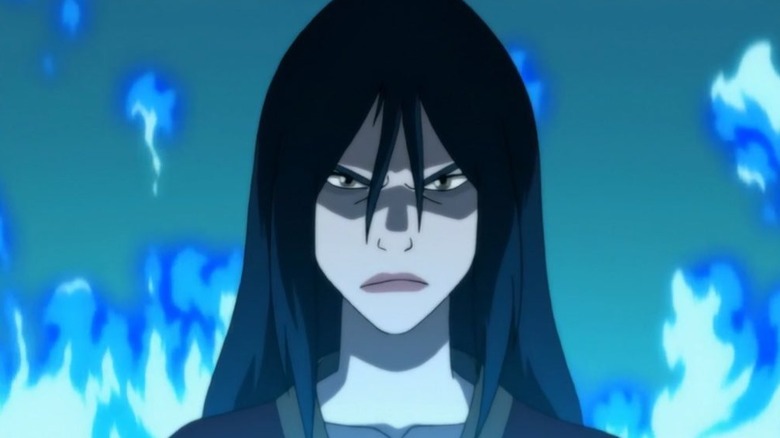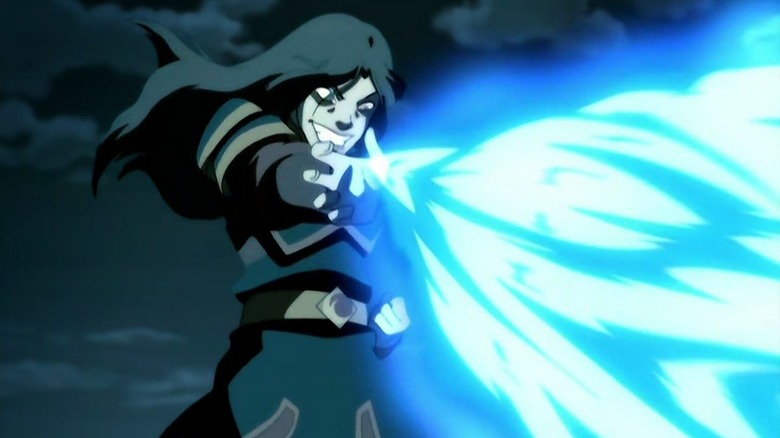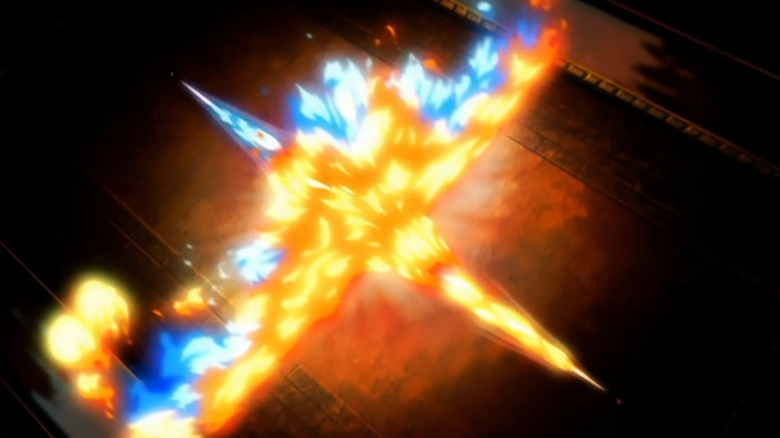Why Is Azula's Fire Blue In Avatar: The Last Airbender?
We may receive a commission on purchases made from links.
"Avatar: The Last Airbender" rose to a whole other level of greatness in its second, and some would say best, season. ("Book 2: Earth.") A lot of that comes down to two new characters the show introduced to its ensemble.
The heroes got a new teammate: Toph (Michaela Jill Murphy), the blind earthbending prodigy. But they also had a new threat to contend with: Fire Nation Princess Azula (Grey DeLisle), who was hunting both Avatar Aang (Zach Tyler Eisen) and her exiled brother Prince Zuko (Dante Basco). Smart, powerful, and ruthless, Azula is seemingly the "perfect princess." She's a firebending prodigy and success comes naturally to her (unlike Zuko, who's always had to struggle).
Another detail that sets Azula apart is her firebending. In "Avatar," where people can bend one of the four classical elements, Firebenders transmute fire out of their own breath and chi and then control the flames. In almost every case seen, the fire that Firebenders use is the familiar red and orange. But not Azula: her flames burn blue.
While Azula claims not to care, even joking her own mother was right to see her as a monster, you see as the show goes on that she's hiding as much pain as her brother. In the series finale "Sozin's Comet," the weight of her own perfectionist expectations upon herself finally come crashing down. Azula ends "Avatar" totally alone and broken. The last time we see her, she's sobbing, writhing, and breathing some of those blue flames in frustrated fury.
"Avatar" spin-off comics have kept Azula's story going since the show's finale, but there's one lingering question: What is up with her blue fire?
There is no canon reason in Avatar for Azula's blue fire
A blue flame burns at a higher temperature than a red flame. In fire, the color blue is the sign of a complete and efficient combustion. Furthermore, in the color temperature spectrum, red sits at the coolest end while blue is at the hottest.
So, to convey Azula's power, the "Avatar" team chose to give her blue fire. In the art book "Avatar: The Last Airbender (The Art of the Animated Series)," series co-creator Michael Dante DiMartino explained: "To symbolize that Azula was a firebending prodigy and more skilled than her brother, her firebending effects were colored blue."
"[Azula] burns hot while [Zuko's] a flicker of the second born," as songwriter Reinaeiry put it. So, some "Avatar" fans have extrapolated that blue fire is the sign of a more powerful Firebender. Some "Avatar" fanfiction accepts it as canonical that blue fire is a rare skill, and Azula conjuring it shows her incredible breed of power. Zuko isn't as gifted as Azula, so of course he can't make blue flames.
But that doesn't quite line up with "Avatar: The Last Airbender," which never offers any real exposition about why Azula's flames are blue. Both Zuko and Azula's father, Fire Lord Ozai (Mark Hamill), and their uncle Iroh (initially Mako, later Greg Baldwin) are stronger Firebenders than Azula. If blue fire is the strongest form of firebending, then shouldn't their flames be blue too? But they aren't.
Could the blue fire just be Azula's own quirk and a natural sign of her innate talent? Problem is, "Zuko Alone" shows that, when Azula was younger, her flames were orange just like Zuko's. The implication is that she refined her ability to make blue fire as she grew up. The show just doesn't provide any information on how or why.
Nor did it need to, of course. The blue flames are simply there to reinforce Azula's characterization. Remember what DiMartino said: Azula's blue fire is there to symbolize her contrasts to Zuko.
Azula's blue fire is all about symbolism
Where does Azula's name come from? Oh sure, in-universe she's named after her grandfather, Fire Lord Azulon. But what about from a creative standpoint? The root of her name is "azul" — the Spanish word for "blue." (One shade of blue is named azure in English, and it shares common etymology with azul.)
It's a fitting name because the color blue reflects Azula in many ways. Blue fire is something of a contradiction in people's eyes. We accept blue as a cool color and red/orange as warm ones, even though the reality of fire is the opposite; blue, the cool color by cultural definition, burns the hottest. This contradiction reflects the essential parts of Azula. She's powerful but doesn't conduct herself in a way you'd expect from a Firebender.
Fire is the element that symbolizes lack of restraint. (Fiery is an adjective often coupled with "passion" or "rage.") When Aang first tries to bend fire in the season 1 episode "The Deserter," he loses control, the flames burst out, and they burn his friend/crush Katara (Mae Whitman). "Uncontrolled" does not describe Azula.
Azula is cold, calculating, manipulative, and totally in control. She's got rage, sure, but it's focused. Despite her mastery over the element fire, she's not that fiery of a person on the surface. She's cool and cold in her cruelty — as cool as blue. That's a total contrast from her hothead brother. Zuko's flames are red-orange, which are colors we considered to be "hot" because red-orange fire is more common than blue fire. Azula thinks with her head, Zuko thinks with his heart.
The defining difference between the siblings is in the season 2 episode "The Chase," where they're both chasing after Aang. Azula pursues Aang into an abandoned building where the upper floor has caved in. She almost falls in but looks before she leaps and catches herself. Zuko, not bothering to look, races in behind Azula and then falls on his face.
Another creative decision for Azula's blue flames was a technical one. In "Avatar: The Last Airbender (The Art of the Animated Series)," DiMartino added that, "Practically, the blue fire also helped distinguish [Azula's] attacks from Zuko's red firebending during their epic battles." When Zuko and Azula have their last Agni Kai in "Sozin's Comet," you can tell which flame comes from which Firebender by its color.
So, it's pretty clear that the "Avatar" team didn't have worldbuilding on its mind when they painted Azula's flames blue. But "Avatar: The Last Airbender" didn't need to explain Azula's blue fire; it was a smart enough show to trust its viewers to glean the meanings themselves. Those meanings lie in symbolism and characterization, not lore.


